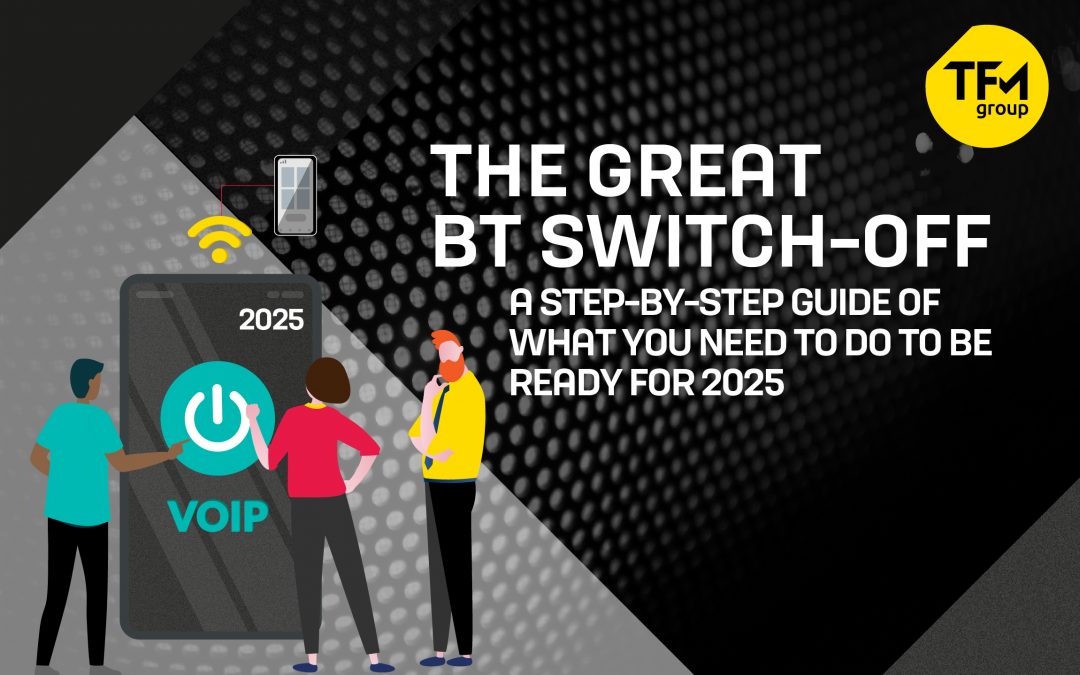A few months ago, we explained the significance of BT’s ‘Big Switch-Off’ and what this drastic comms transition will mean for businesses across the UK. To recap, by 2025, BT is planning to switch off its outdated ISDN fixed-line network and move to an entirely IP-based model of voice communication. From then on, you will be using digital phone services – whether you’re ready or not.
The good news is, moving to an IP phone system is easy (although it doesn’t appear by magic). Millions of businesses have already made the switch. You can join them by taking a few simple steps.
#1: Review your contracts
First up, find out when your current contract is due to end. This will give you a rough timeline for making the switch to a digital telephony system. You’ll want to have the new system in place by the time your current contracts come to an end.
Don’t be tempted to renew your existing fixed-line contracts for another year or two for the sake of an easy life. You will have to switch to VoIP (Voice Over IP) eventually, and you may well be throwing money away if you continue with a soon-to-be-scrapped legacy system.
Plus, there are bound to be last-minute delays and bottlenecks as everyone rushes to catch up in 2025. Smart businesses plan ahead to stay ahead.
#2: Sort out your connectivity
To ensure a reliable IP-based telephony service with jitter-free video conferencing and enough juice for your collaboration tools, you will need access to a robust and reliable internet connection, like fibre. For larger businesses, there may be benefits to using a dedicated one-to-one connection with no bandwidth restrictions via an Ethernet-based leased line.
If your service is patchy then you might want to think about upgrading. TFM can help you with this, just get in touch.
#3: Figure out your needs and preferences
Businesses use phone lines for more than just phone calls. Everything from alarms, door entry systems, cash machines, POS systems and lift emergency call buttons can operate through your ISDN network, so make sure you know how these services work so you can avoid any complications.
Once you know where you stand with current services – including your current and projected call volume and patterns – you might want to start thinking about which of the following features would be useful to your business:
- Caller ID
- Call forwarding
- Conference calling
- Voicemail
- Voicemail to email
- Interactive Voice Response (such as a welcome message and dialling options)
- Voicemail and Voicemail-to-email
- Call recording
- Custom ringtones
VoIP comes with all sorts of options. You can narrow down the choices considerably by conducting a needs audit before you start to shop around.
#4: Consider hosted versus on-site VoIP
Another factor that comes into play when choosing the right system is deciding whether to go with an on-site IP-PBX (private branch exchange) or hosted system.
With an onsite PBX, all the hardware such as computer equipment and desk sets reside at your office, and the signalling is done with an IP phone to the IP-PBX server using a LAN. With a hosted system, the provider handles all the signalling, technology and features required through a server at the provider’s location.
There are pros and cons of both systems – the biggest considerations being ownership, security and cost. Smaller businesses tend to opt for a cloud-based hosted solution as it requires minimal capital expenditure compared to an onsite system. All you pay is a monthly per-user fee, and you can easily scale up with additional users, handsets or features as you need them to support your business growth.
Some hosted providers don’t offer the same features in their hosted product as they do for their premises-based solution, however, so we recommend that you take advantage of a free consultation with an expert like TFM to ensure your new system will support your commercial goals.
#5: Think about the hardware
When upgrading to VoIP, you may need to invest in new handsets if your current kit is not compatible with your new system. There’s a vast array of options on the market. Our best advice is to resist rushing in, and really take the time to understand what your employees need to communicate both internally and externally.
For instance, many businesses will not need a like-for-like replacement of all their hardware since their working patterns are radically different now than they were before COVID. If you are one of the many organisations that has built work-from-home or hot-desking into your staffing model, then giving everyone a desk phone is going to be less valuable than making sure everyone has a smartphone, headsets and the right apps that let them work from anywhere.
There’s no right or wrong answer here. Everyone’s needs will be different. The key point is to make sure your people can be easily trained on the new tech, are excited and energised about it, and find it easy to use. Ask us for advice if you’re not sure.
Get a helping hand!
The great switch off is nearly upon us and purchasing the right replacement phone system is going to be critical for the future success of your business. There are many factors that come into play when choosing your new system, and each will make a difference to the features you have at your disposal, your costs, and the ease of set-up and scale-up.
It’s a journey we can help you navigate. Whether you’re an established business or an ambitious start-up, we can help you find the most flexible, cost-saving and scalable solution that has the potential to boost your productivity. Give us a call today!


